|
|
ETCHED BEADS
The art of bead etching most probably began in the Indus Valley Civilization.
Indians were the first to etch beads with soda, and from
there the art spread along the trade routes to other
countries. Etching was accomplished by applying an
alkali, usually a soda or plant ash solution, and heat
to the stone surface. This would cause the stone to
become discolored or frosted in appearance, creating the
design. The process required precise control of the
chemical application and heating process, and the
artisans of the Indus Valley were skilled at it.
These etched beads from the Indus Valley civilization
have been found not only in the Indus region itself but
also at sites across the ancient world, from Mesopotamia
to Central Asia and Egypt. This suggests that they were
highly valued trade goods, and their spread helped to
disseminate the bead etching technique to other
cultures.
Displayed below you can see etched Indus Valley beads from Pakistan.
|
The beads in
my collection
are now for sale
Inquire
through bead ID
for price
|
|
|
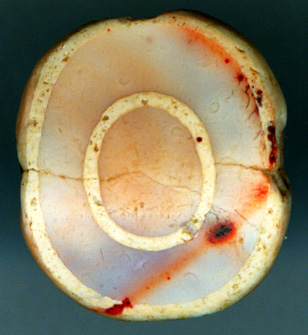
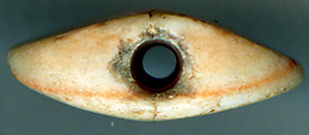
EB 0 - 13 * 11 * 5 mm
- SOLD
|
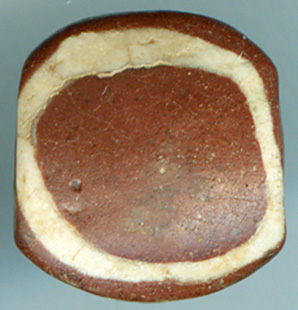
EB 3 -
12 * 4,5 mm - SOLD
This bead is actually not etched,
but displays natural lines in
jasper stone.
|
|
The wonderful etched eye bead to the left is designed in the rare double ax form. This design is even older than the designs from the Indus Valley culture. They can
in West Asia be dated back to the Neolithic period.
LINES, CONTRAST, PATTERN, AND SHAPE
|
|
|
|
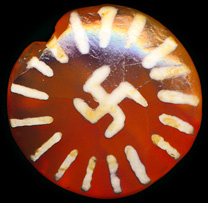
EB 1 - 12,5 * 4,9 mm
|
In evaluating the artistic and
historical significance of etched beads, there are several key aspects
to consider.
Line quality
The precision, delicacy, and uniformity of the etched lines can tell us
a lot about the skills of the artisans who made the beads. The thickness
of the patterns, especially in well-preserved beads, can be indicative
of high quality craftsmanship, as seen in some of the ball beads you
mentioned.
Contrast
The contrast between the etched design and the underlying color of the
bead material is another important factor. A high degree of contrast not
only enhances the visual impact of the bead but also demonstrates the
bead maker's mastery of the etching process, which involves carefully
controlled application of alkalis and heat.
Pattern uniqueness
The rarity and distinctiveness of the etched patterns can significantly
increase the artistic and historical value of the bead. A bead might
have a perfectly executed but common design, or it might have a unique
and unexpected pattern that sets it apart, like the bead with the rare
variation on the typical cruciform. Such designs offer unique insights
into the cultural and symbolic world of the people who created and wore
these beads.
Bead shape
Lastly, the overall shape and form of the bead itself is an important
consideration. The shape can often be linked to specific cultural
preferences or symbolic meanings. For instance, the bead with a
perfectly oval shape and a flat backside is an intriguing example of the
variety of forms produced by ancient bead makers.
The analysis of these factors together provides a comprehensive
evaluation of the aesthetic and cultural significance of etched beads.
It also reveals the expertise and creativity of the ancient artisans who
created these enduring works of art.
Ancient, but never used |
|
|
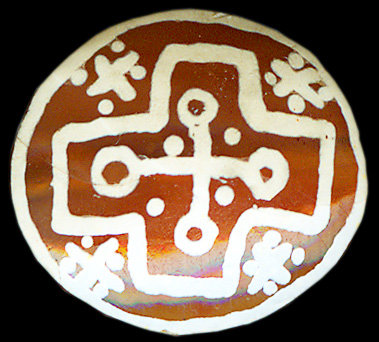
|
Taxila,
Pakistan?
EB 2
15 * 13 * 4,5 mm |
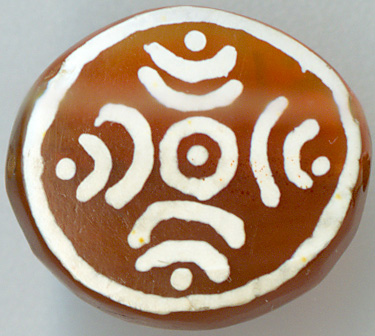
|
|
This distinctive flattened oval bead
indeed presents a fascinating case study in bead history. Despite its
pristine condition, which led some observers to initially suspect it
might be a modern creation, the presence of iron oxide within the etched
lines on the backside of the bead provides compelling evidence of its
ancient origin. The penetration of iron oxide into these etched lines is
a slow process that takes an extended period, commonly referred to as
'geological time'. This supports the hypothesis that the bead is indeed
ancient.
Additionally, the bead's rich patina, likely a result of prolonged
burial, provides further corroborative evidence of its antiquity. Its
apparent unused condition suggests that it might have been a burial
casket bead, intended for ritual use rather than everyday wear.
The bead's relatively small hole, in contrast to the larger holes
typically found in the ball beads from the same period, might hint at an
evolution in bead-making techniques or aesthetic preferences over time.
It suggests that the bead could date from the later stages of the
Greater Buddhist India period.
In terms of its design, the complexity of the etched pattern seems to
mirror the trend in the evolution of Buddhist symbology, such as the
mudras or symbolic hand gestures of the Buddha. As Buddhism evolved and
spread, the
language of these symbols became increasingly intricate and nuanced,
a development that seems to be mirrored in the bead's intricate design.
In sum, this bead provides valuable insights into the artistry, ritual
practices, and cultural evolution of its era. It highlights the
importance of careful analysis in bead study, illustrating how even
seemingly contradictory features can come together to tell a complex and
intriguing story of the past.
|
|
|
|
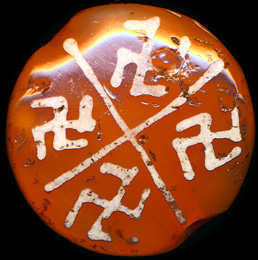
EB 3 - 16 * 8 mm - SOLD
|
|
|
|
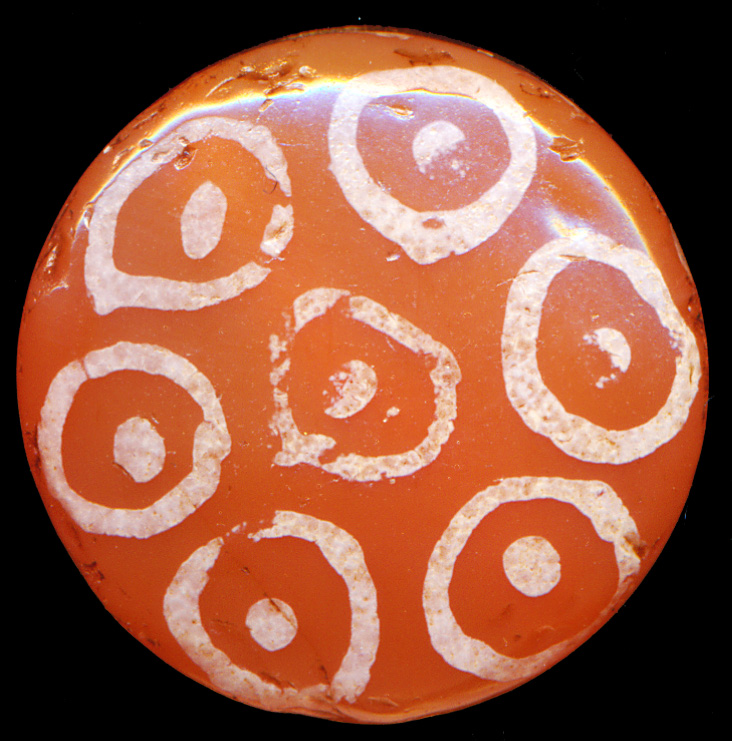
EB 4 - 14,5 * 8 mm - SOLD
|
|
Black decoration
Beads
adorned with black etchings are significantly rarer,
marking a unique and intricate process in their
creation. In this particular method, the entire bead
initially undergoes a soda treatment. This step turns
the surface of the bead white, as seen in the examples
of EB 20 & 21. Subsequently, the desired patterns are
etched onto this blank, white canvas.
However, the etching in this case is not performed with
soda. Instead, a solution of iron or manganese compounds
is employed, which imparts a black hue to the etched
designs, standing out distinctly against the white
surface of the bead. This process, though
labor-intensive, results in strikingly beautiful and
distinctive beads, lending a rare quality to the pieces.
This technique is discussed in detail in S. B. Deo's
work, 'Indian Beads'.
|
|
|
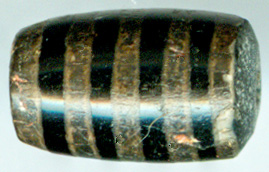
EB -
11 * 6,5 mm
- SOLD
|
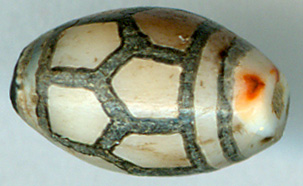
EB -
11 * 7 mm - SOLD
|
|
|
|
|
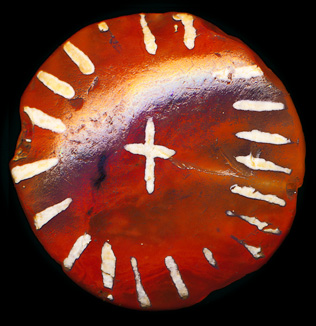
EcthedIndus 1 - 19 * 8 mm SOLD
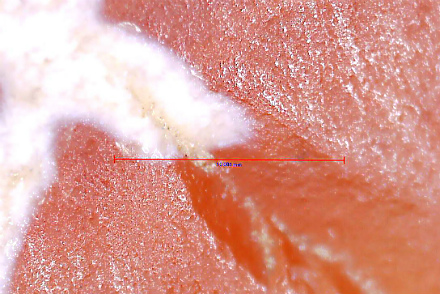
Zoom in
|
|
|
|
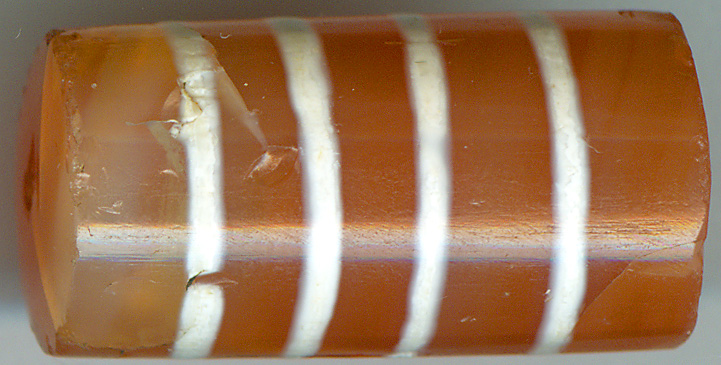
EB 26 -
29 * 15 mm
(Brm 28)
|
|
|
|
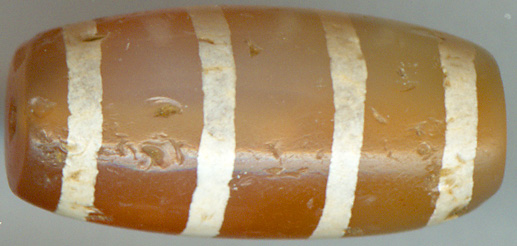
EB 29 -
21 * 10 mm
|
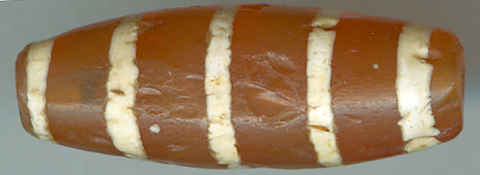
EB 30 -
19 * 7 mm |
|
|
|
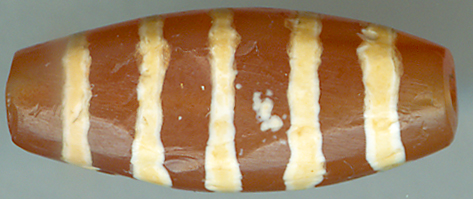
EB 31 -
18,5 * 4,5 * 8 mm
|
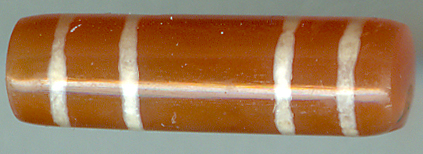
EB 32 -
17 * 5 mm
- SOLD |
|
|
|
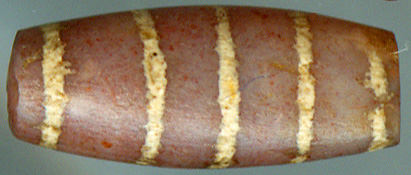
EB 33 - 16,5 * 7 mm |
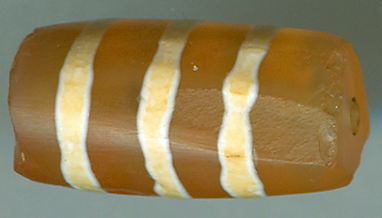
EB 34 -
15 * 7,5 mm
|
|
|
|
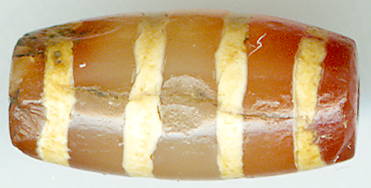
EB 35 -
15 * 7 mm
|
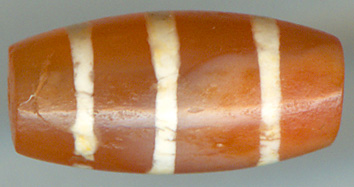
EB
36 - 14 * 6,5 mm |
|
|
|
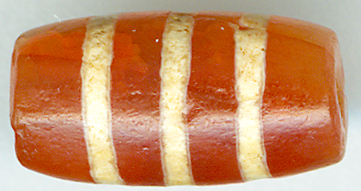
EB 37 - 14 * 7 mm
- SOLD
|
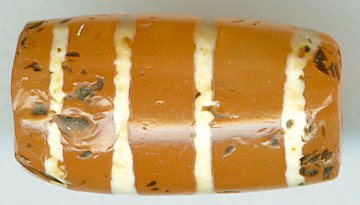
EB 38 - 14 * 7 mm
- SOLD |
|
|
|
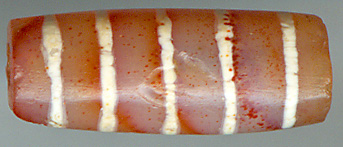
EB
39 - 13 * 5 mm
|
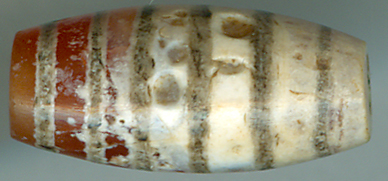
EB 40 - 15 * 7 mm
|
|
|
|
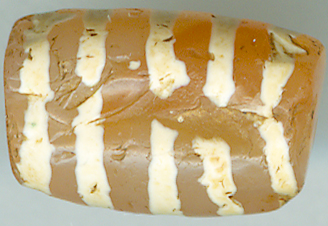
EB 41 -
13 * 8 mm
|
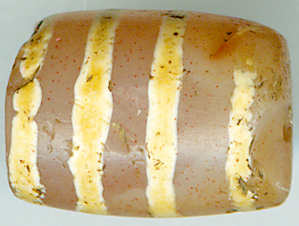
EB 42 -
12 * 8 mm |
|
|
|
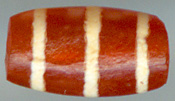
EB 43 -
11 * 5,5 mm
|
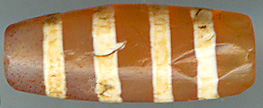
EB 44 - 10 * 4 mm |
|
|
|
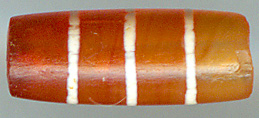
EB 45 - 10 * 4 mm
|
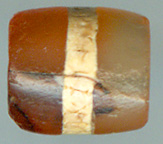
EB 46 - 6 * 5 mm |
|
|
|
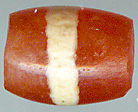
EB 47 - 5 * 4 mm
|
|
|
|
|
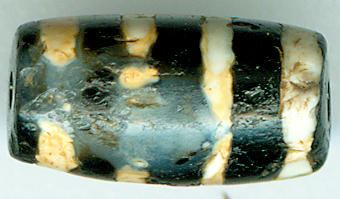
EB 22 -
14 * 7,5 mm
- SOLD
|
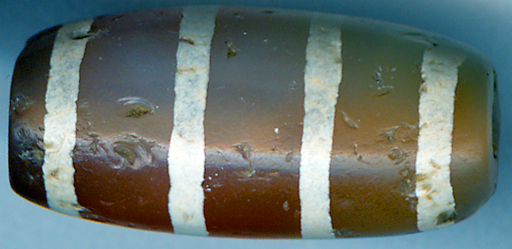
EB 23 -
14 * 7 mm
- SOLD |
|
|
|
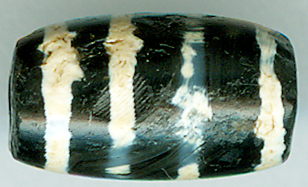
EB 24 -
12 * 6,7 mm
- SOLD
|
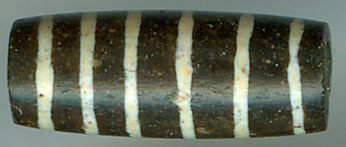
EB 25 -
13 * 5 mm
- SOLD |
|
|
|
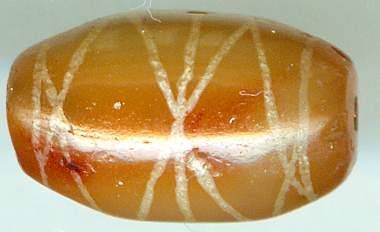
EB 48 -
15 * 9 mm
|
|
The bead displayed above was sourced from
Burma. It has a typical Burma pattern. However it could be found anywhere within the ancient Buddhist kingdom of greater India.
Beads are great travellers.
|
|
|
|
|
|
|
|
Above 3 etched beads from Burma with typical Burma
design
|
|
|
|
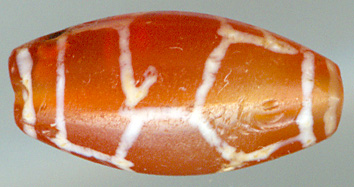
EB 52 -
14 * 7 mm
- SOLD
|
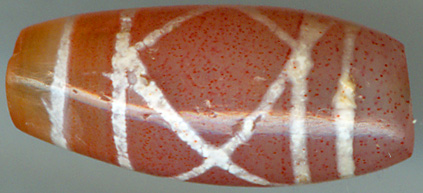
EB 53 -
17 * 7 mm |
|
|
|
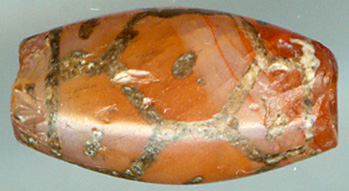
EB 54 - 11 * 6 mm |
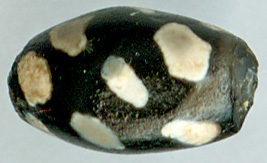
EB 55
- 10 * 6
mm
|
|
|
|
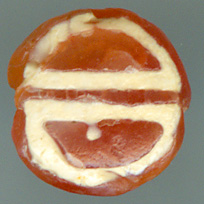
EB 56 -
8 * 4 mm -SOLD
|
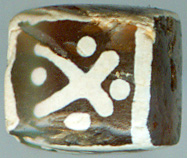
EB 57 - 7 * 6 mm
-SOLD |
|
|
|
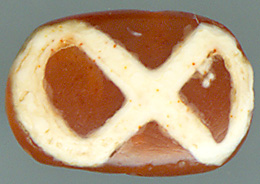
EB 58 -
10 * 7 * 4 mm - SOLD
|
|
|
|
|
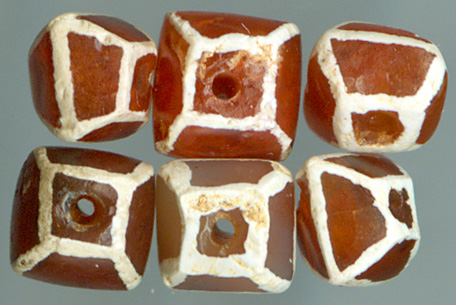
EB 59 -
5 mm
|
|
|
Most probably the small white dots were made to serve as protective eyes. Ancient beads were used, not only as decoration,
but as amulets.
Sourced from Nepal.
DIFFERENT ETCHINGS REFLECTS DIFFERENT SOCIAL STRATA IN SOCIETY
The beads shown below
offer a glimpse into the different social strata of
ancient societies, as reflected through the quality and
intricacy of bead etching. A spectrum of etched beads is
presented, ranging from medium quality to the simplest
forms. Each bead's intricacy, design, and execution can
potentially tell a tale of the owner's social standing,
starting from the sophisticated bead on the left and
concluding with the group of simpler beads displayed in
the final photo.
The exquisite Swastika bead, EB1 likely belonged to an
individual of high social status or wealth. Its
meticulous etching, intricate design, and superior
quality materials signify a high level of craftsmanship,
typically accessible only to the elite. Such beads would
have been coveted status symbols, signifying power,
prestige, or wealth.
As displayed below, the beads become increasingly
less intricate and less carefully executed. These
may have belonged to the middle strata of society -
individuals who had enough resources to afford
decorative beads, but not the finest ones. The designs
on these beads are simpler, but they still represent a
form of personal adornment and status.
Finally, the group of beads at the bottom represents the
most basic level of etched beads. These beads are the
simplest in terms of design and craftsmanship. The
etchings are rudimentary, and the overall execution
lacks the refinement seen in the higher-quality
examples. These beads may have been accessible to the
broadest swathe of society, including those of lower
social status.
This gradation of bead quality and intricacy likely
mirrored the stratification of society, offering a
tangible and enduring record of the social dynamics of
the time. Each bead, regardless of its quality or
intricacy, served as an expression of personal identity
and social standing. As such, they offer invaluable
insights into the past, reflecting not only the
aesthetic preferences of the period but also the
socio-economic structures of these ancient societies.
|
|
|
|
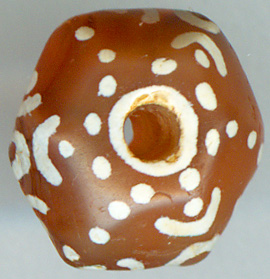
EB 67 -
11 * 7 mm - SOLD
|
|
|
|
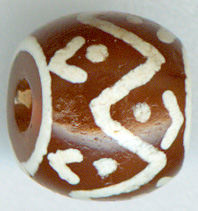
EB 68 -
7 mm
|
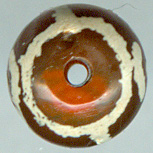
EB 69 -
6mm |
|
|
|
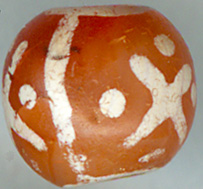
EB 70 - 7,5
mm
- SOLD TO HERVE |
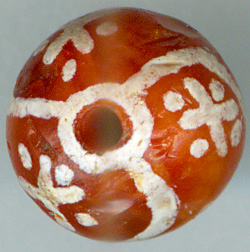
EB 70 -
10 mm
|
|
|
|
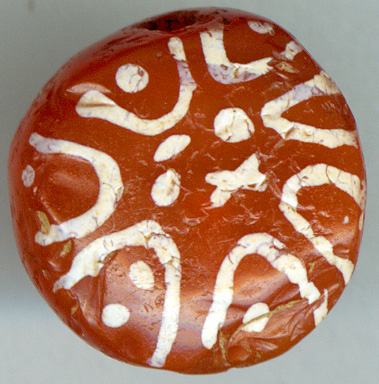
EB 71 -
15 * 7 mm
- SOLD TO HERVE
|
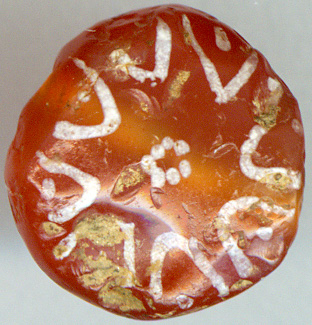
EB 72 -
13 * 6 mm - SOLD |
|
|
|
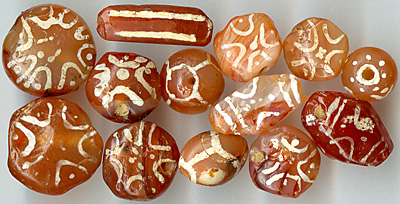
EB 73 - SOLD
|
|
|
ETCHED BURMESE BEADS
You will find the etched Pumtek Beads
on this link. They are
so typically Burmese that I chose to display them on the
Burmese Beads page.
Military beads?
This ancient carnelian Pyu bead has been colored by oil, gas, and pressure.
You can read more about it here. On the
internet, these kinds of beads are presented as military beads. I find it odd that a peaceful Buddhist culture like the Pyu's would have so many beads with military symbols. Stripes on beads, especially carnelian beads, are found everywhere in Greater India. The stripes most probably indicate animistic magic properties in a Buddhist context. However, particular this bead is typical for Burma and not for India.
|
|
|
|
Etched Carnelian with 4 stripes
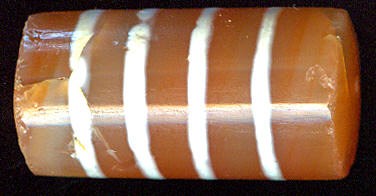
EBB
76
-
29 * 15 m
|
|
|
|
Etched Carnelian with 5 stripes
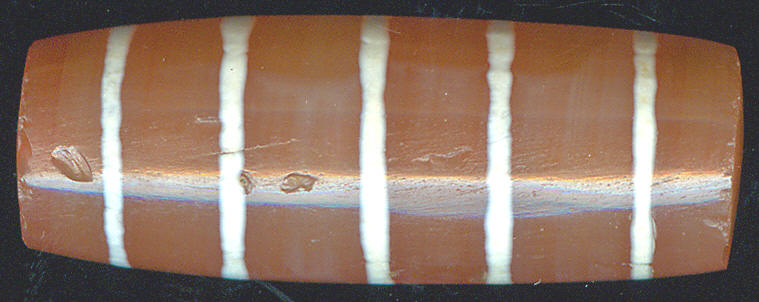
EBB
77
-
31 * 11 mm
|
Most probably many of these etched carnelian beads have traveled between India and Burma with Buddhist monks and traders more than 1000 years ago. They were found in Matehtilay, Maline.
Burma embraced Theravadan Buddhism, influenced from Thailand around 1050. These artifacts, however, show the strong and direct Indian cultural influence during the times of the Pyu City states from 200 B.C. to around 1000 A.D.
|
|
|
|
Striped Burmese Ball Beads
|
|
|
|
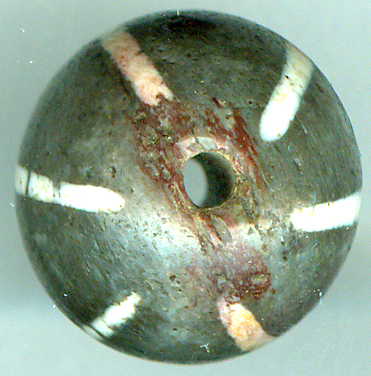
EBB
80
-
15 mm
|
|
|
|
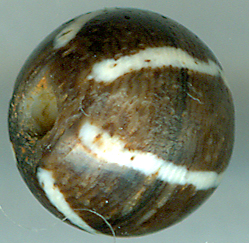
EBB
82
-
9,5 mm
|
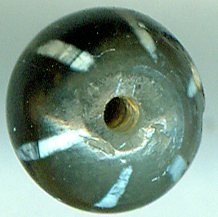
EBB
83
-
9 mm
|
|
|
|
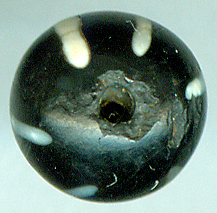
EBB
84
-
10 mm
|
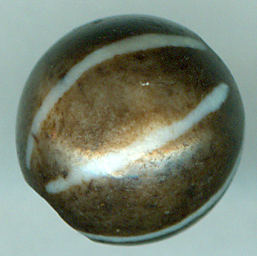
EBB
85
-
10 m
|
|
|
|
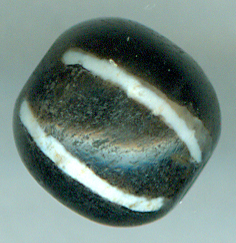
EBB
86
-
8,3 mm
|
|
|
|
|
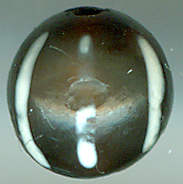
EBB
88
-
7,5 mm
|
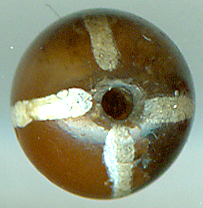
EBB
89
-
10 mm
|
|
|
|
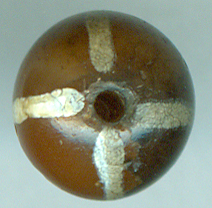
EBB
90
-
8 mm
|
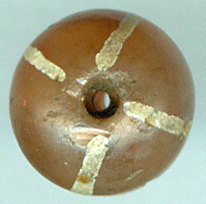
EBB
91
-
8 mm |
|
|
|
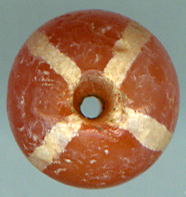
EBB
92
-
7 mm
|
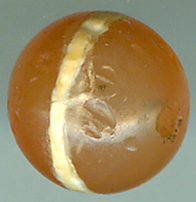
EBB
93
-
8 mm |
|
|
|
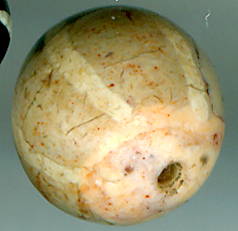
EBB
94
-
10 mm
|
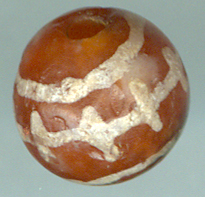
EBB
95
-
7,5 mm
|
|
|
|
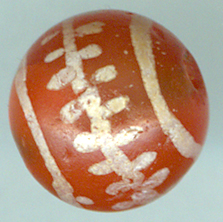
EBB
96
-
8,5 mm
|
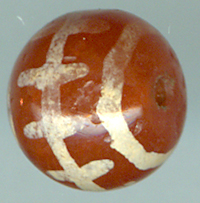
EBB
97
-
7,5 mm |
|
|
|
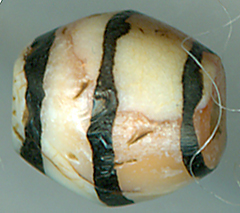
EBB
98
-
9 * 8 mm
|
|
|
|
|
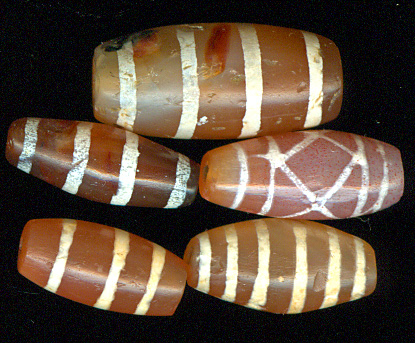
EBB
100
-
Upper: 21 * 10 mm
Click on picture for larger image
|
|
|
|
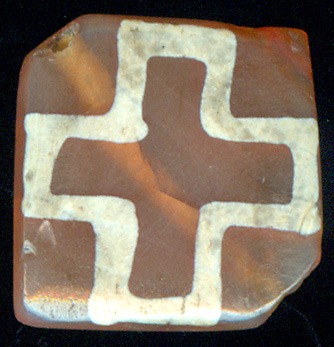
EBB
101
-
13 * 3,5 mm
|
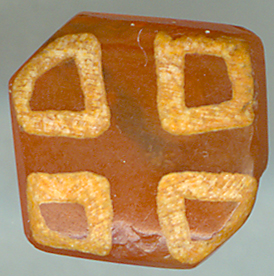
EBB
102
-
11 mm
|
NEW ETCHING ON OLD BEADS
Here you can observe a primitive etching on beads with poorly crafted forms. I showed the photo of these beads to some expert bead hunters in Burma. They called these beads 'village beads'. They said that they in their bead hunting had observed a great difference between beads found in ancient city areas and in village areas. It seems that the custom of poor people copying the finer crafted rich man's city beads in these more crude forms was widespread.
|
|
|
|
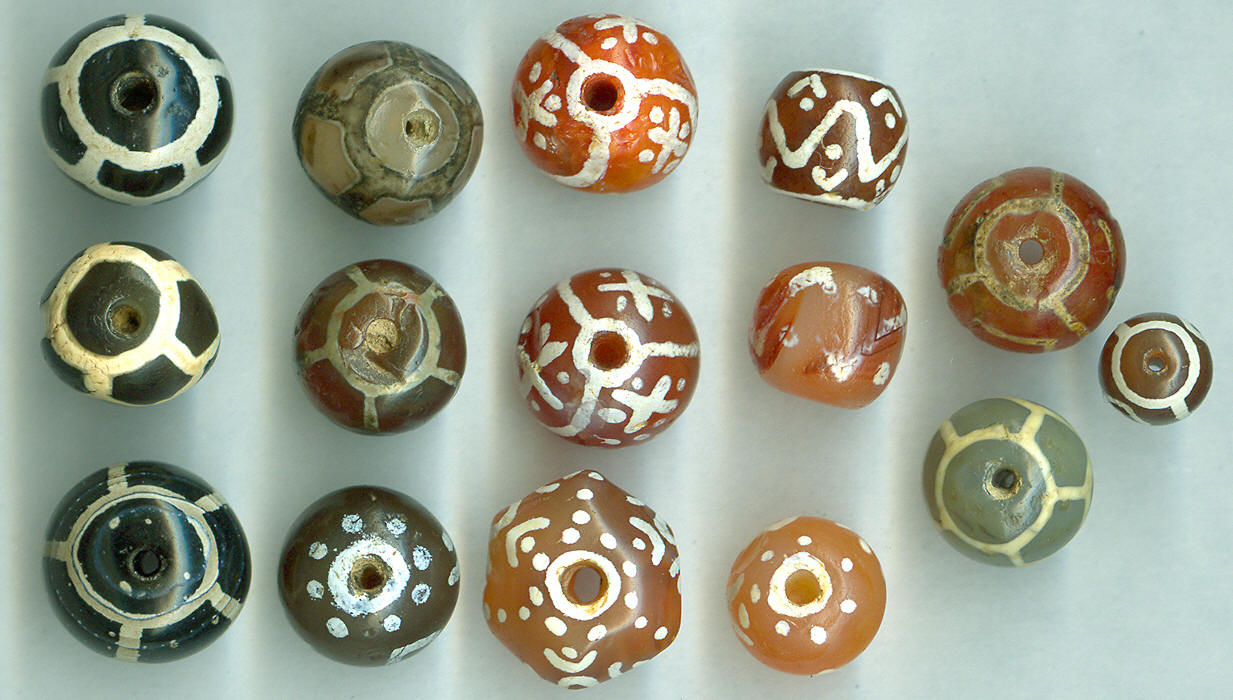
Largest bead upper left: 11 mm
|
Nowadays one has to be extremely careful when purchasing etched beads.
One of the etched beads displayed above is most probably a fake. The bead itself is old, but the etching is new. Can you identify the bead?
Here are some more examples of new etchings made on old beads:
|
|
|
|
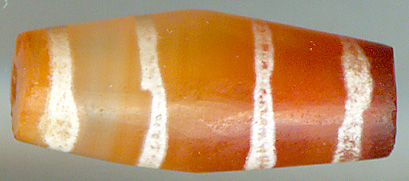
|
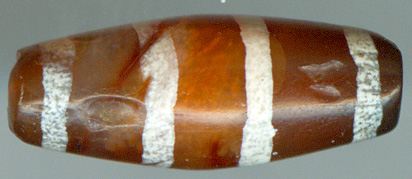 |
|
As a general rule
new etchings are thin, almost transparent, as one can clearly see in the beads above. Often one can observe how the new etching follows the old marks in the beads in a way that it would not do if the etching was as old as the bead itself. Note the way how the etching follows the crack in the lower left corner of the bead displayed below.
If the etching is as old as the bead itself, the lines would have disappeared
in there areas where later small damages occur, as you can see in the bead below:
|
|
|
|
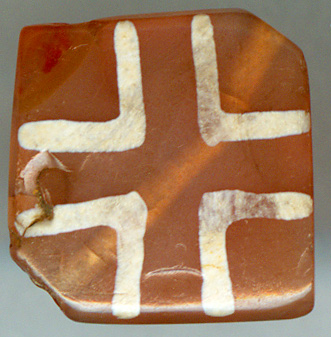
|
|
|
|
|
| | | |